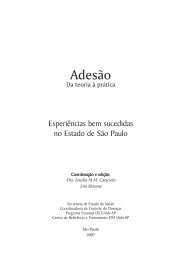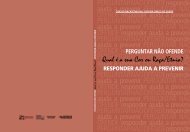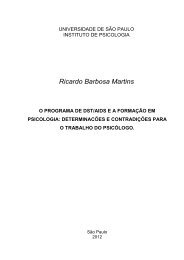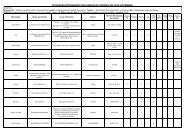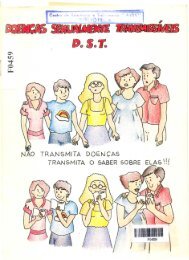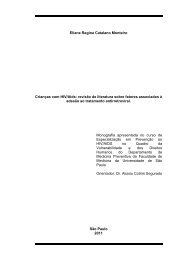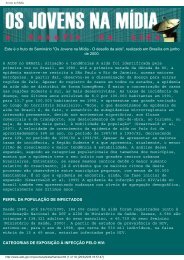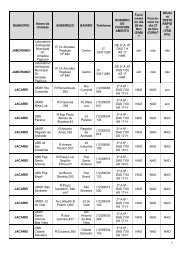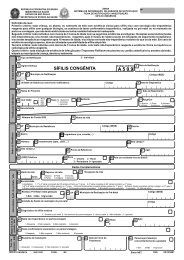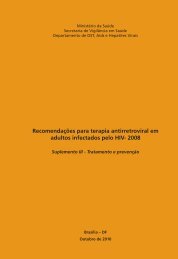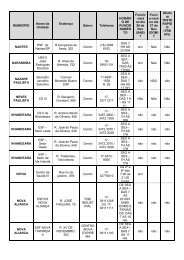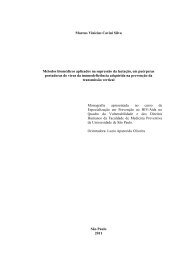A Construção do “ser médico” - Centro de Referência e Treinamento ...
A Construção do “ser médico” - Centro de Referência e Treinamento ...
A Construção do “ser médico” - Centro de Referência e Treinamento ...
You also want an ePaper? Increase the reach of your titles
YUMPU automatically turns print PDFs into web optimized ePapers that Google loves.
Abstract<br />
Silva GSN. The building of the “<strong>do</strong>ctor being” and the <strong>de</strong>ath: meanings and<br />
consequences to care humanization. [thesis]. São Paulo: Faculda<strong>de</strong> <strong>de</strong><br />
Medicina, Universida<strong>de</strong> <strong>de</strong> São Paulo; 2006. 276p.<br />
we have sought the un<strong>de</strong>rstanding of the process for building a “<strong>do</strong>ctor<br />
being” and its relation to the phenomenon of <strong>de</strong>ath, based on the narratives<br />
of stu<strong>de</strong>nts in the process of becoming <strong>do</strong>ctors. A qualitative research took<br />
place with the medical school stu<strong>de</strong>nts from the Fe<strong>de</strong>ral University of Rio<br />
Gran<strong>de</strong> <strong>do</strong> Norte, chosen from all levels of the un<strong>de</strong>r-graduation (from the<br />
first year to medical resi<strong>de</strong>ncy), with the objective of investigating how this<br />
relation with <strong>de</strong>ath helps to promote the <strong>de</strong>tachment among the medical<br />
scientific technologies and the dialogical processes of caring in the daily<br />
medical practice. The existential phenomenology, Gadamer´s Hermeneutics<br />
and the theory of communicative action, of Habermas, constitute the<br />
philosophical basis of the narratives production and interpretation work. To<br />
produce the narratives two techno-metho<strong>do</strong>logical strategies were combined:<br />
In <strong>de</strong>pth interviews with scripts and workshops using projective role-play<br />
activities, seeking for a <strong>de</strong>eper and sufer in the interpretative analysis. The<br />
results were grouped in seven theme categories: 1) Concepts of a “<strong>do</strong>ctor<br />
being”; 2) Concepts of <strong>de</strong>ath; 3) Concepts of the stu<strong>de</strong>nts/resi<strong>de</strong>nts about<br />
facing the process of a patient´s <strong>de</strong>ath; 4) Death approaching; 5) The<br />
medical initiation; 6) Meeting <strong>de</strong>ath through a scene; 7) Desires of change in<br />
the medical education. The analysis and reflections <strong>de</strong>veloped point towards<br />
the i<strong>de</strong>a that a “<strong>do</strong>ctor being” is connected to the i<strong>de</strong>al of being a good<br />
<strong>do</strong>ctor, which means being technical and human in the illness and <strong>de</strong>ath<br />
processes. Although part of a social and institutional culture of <strong>de</strong>ath <strong>de</strong>nial,<br />
the interviewed stu<strong>de</strong>nts revealed sensibility to the re-humanization of the<br />
<strong>de</strong>ath process. These conceptions are also present in the new curriculum<br />
proposal, but they find tension facing the biomedical mo<strong>de</strong>l which they are<br />
inclu<strong>de</strong>d. The anatomy initiation <strong>de</strong>fines one type of path to be followed,<br />
based in the expropriation of subjectivity, where the <strong>de</strong>tachment of emotions<br />
is the guarantee of objective knowledge. The prescription of a noninvolvement<br />
is a<strong>do</strong>pted, coexists with signals of relativization (to not get too<br />
involved), when the aim is humanization in the medical practice, which<br />
prescribes a good communication with the patient about to die. The stu<strong>de</strong>nts<br />
move between these two scenarios, with rare role-mo<strong>de</strong>ls, few experiences<br />
to name and <strong>de</strong>al with <strong>de</strong>ath, and many para<strong>do</strong>xes. In their meeting with the<br />
patient to die, the caretaker faces the difficulties of not promoting the<br />
distance between intention and gesture in their interactions. They reclaim a<br />
medical education able to re-gather sense and emotion; <strong>do</strong>ctor and patient;<br />
technique and caring; life and <strong>de</strong>ath. The work suggests, at last, the<br />
advances towards existential ontology, from the philosophical-hermeneutics<br />
and the communicative reason as ways to a conceptual consolidation able to



